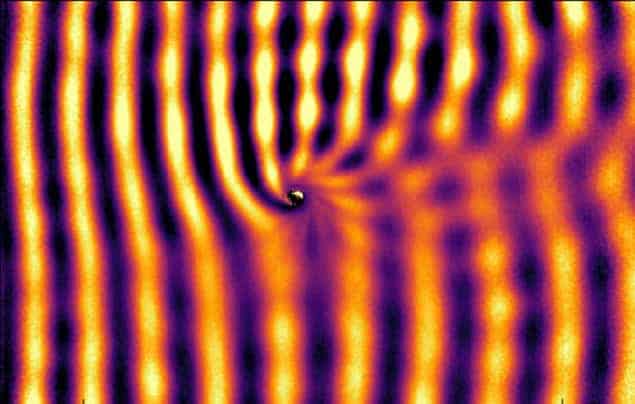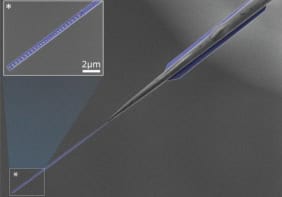
Water waves can gain energy when they scatter from a whirlpool-like vortex. That is the conclusion of physicists in Brazil, Canada and the UK, who are the first to observe a phenomenon called “rotational superradiant scattering”. The team says that the effect could be used to study black-hole physics.
Silke Weinfurtner and colleagues at the University of Nottingham, Universidade Federal do ABC and University of British Columbia observed the effect using a rectangular water tank 1.5 m long and 3 m wide. Water is pumped continuously into one corner of the tank and allowed to drain through a 4 cm-diameter hole in the middle of the tank – creating a familiar draining vortex.
Controlling the flow so that the water is always about 6.25 cm deep, the team then generated plane waves from one side of the tank with excitation frequencies in the 2.9–4.1 Hz range. An “absorption beach” is located on the opposite side of the tank to minimize the effect of the waves reflecting back into the tank.
Simple bathtub
Using a special 3D sensor developed by the team, the researchers were able to precisely measure the height of the waves passing through the swirling vortex at the centre of the tank. According to the team, images of the waves at various excitation frequencies agree with “simple bathtub flow models”. Furthermore, the plane waves undergo an angular phase shift upon scattering, analogous to the Aharonov–Bohm effect in quantum mechanics.
The team also looked at how the waves interact with the vortex by expressing the incident waves in terms of azimuthal components relative to the rotational direction of the water. Azimuthal wave components rotating in the opposite direction as the vortex were found to have lower energy upon scattering, which the team says is the result of energy being absorbed by the vortex hole. However, azimuthal wave components rotating in the same direction as the vortex gained energy as a result of superradiant scattering, with a maximum amplification of about 14% for waves at 3.7 Hz.
The team points out that exactly how energy is lost to the vortex is not known and this could be the subject of future experiments that try to measure the amount of wave energy that goes down the drain. These experiments could provide insights into black holes, which can be modelled in terms of waves interacting with water swirling out of a tank.
The study is described in Nature Physics.



